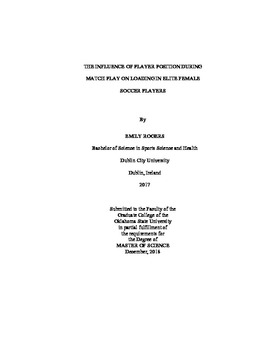| dc.description.abstract | This study aimed to examine the influence of player position on match play loading, determined by GPS and accelerometer data, in a team of elite female soccer players in Northern Ireland. Players (n=16) were divided into 3 positional groups: defenders (n=6, obs=12), midfielders (n=8, obs=18) and forwards (n=3, obs=6) and data was gathered over 5 matches. Total distance (TD), average and max speeds (AS and MS), accelerations and decelerations (ACC and DEC), high-speed running distance (HSRD), sprint distance and count (SD and SC), dynamic stress load (DSL), total load (TL), explosive distance (ED), high metabolic load distance (HMLD) and equivalent metabolic distance (EMD) data were collected for analysis. Midfielders and forwards covered a significantly further TD than defenders on average (14%, p=<0.001, and 13%, p=0.006, respectively), they also recorded more SC (41%, p=0.036 and 76%, p=0.003, respectively) and covered significantly further SD (57%, p=0.020 and 102%, p=0.002 respectively) than defenders did. Midfielders and forwards covered significantly more HSRD than defenders (31%, p=0.025 and 39%, 0.0125, respectively). Midfielders and forwards also had significantly faster average speeds than defenders (14%, p=0.020 and 15%, p=0.002, respectively) and forwards had significantly faster max speeds than defenders (56%, p=0.014). Midfielders and forwards performed significantly more ACC than defenders (38%, p=0.005 and 48%, p=0.009, respectively) and forwards performed significantly more DEC than defenders (48%, p=0.028). Midfielders and forwards covered greater HMLDs than defenders (34%, p=<0.016, and 61%, p=0.001, respectively), and they also presented with significantly higher EMD values than defenders (15%, p<0.001 and 17%, p<0.001, respectively). In contrast, there were no significant differences observed between any positional groups for DSL, TL, or ED. It is clear that elite soccer forwards and midfielders have similar workloads, which are greater than for defenders during match-play. The results of this study may be useful to coaches by giving them more information on positional differences in physiological demand during match play, which should be taken into consideration when designing and implementing training plans. | |
